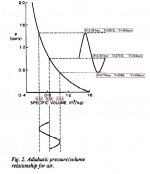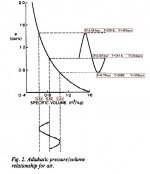This is something I've become very sensitive to, meaning that most systems get the thumbs down immediately when I listen ...When you hear and “learn” that “amplified” acoustic signature, often you can also then hear it when you listen to the speaker playing live.
Frank
In French, it means "You and fire."Tu et feu! '-)
Is what you wanted to say ?
In French, it means "You and fire."
Is what you wanted to say ?
More likely to be "fou!" = mad
I see yus guys haven't bothered to read Absolute Listening Tests-Further Progress 😀... One interesting part was that some speakers sounded bad just hearing them through a measurement mic and good headphones ... Out doors with no close reflections you hear / measure the loudspeaker itself, when you place it in a room, you add the room and now the system’s directivity and placement in the room plays a VERY strong role in governing how fast everything falls apart.
Not that I'd expect anyone to believe stuff from beach bums.
The interesting bits are what was expected and what was unexpected. It shows the Room Interface Profile as most important and practically everything we measure at 1m on treble unit axis bla bla (or your favourite prejudice) as almost irrelevant. In fact Tom Danley's youTube link shows that quite clearly.
There's a treasure chest of such recordings at ambisonia.com These are Ambisonic surround recordings and you need a decoder to hear them in stereo, your zillion.1 system or headphones. Try VVM or Harpex.The best part (I prefer good headphones for this) is that you capture sounds around your house that you are totally familiar with and at times they can make the hair stand on the back of your neck (if your also prone to that kind of response).
I used to have some recordings on our old web site using a stereo capture array thing I am working on. Nothing exciting just stuff from around the yard like a train, motorcycle and fireworks. It’s still kind of cumbersome to move around so these were “organic” sounds haha. I hope they will eventually put them back up when the webtoids are working on it, I was pleased with the “space” they captured.
ajh for classical, pwhodges for choral stuff, soundmanjohn for effects .. though I'm wary of typecasting as there's loadsa good stuff here. No compression and some of the best recordings I know.
Let me know what you think if you have a listen.
Last edited:
And for us tightar**s, what did it have to say ...? 😀I see yus guys haven't bothered to read Absolute Listening Tests-Further Progress 😀
Frank
I tried, but it looks like some private club restricted access.I see yus guys haven't bothered to read Absolute Listening Tests-Further Progress
Alas, as a beach bum, I've been chucked out of the club. 😡 But I'm sure Mr. Danley is still a member .. as are those of you with stocks of 62' Yquem. I'm drooling as I type this.I tried, but it looks like some private club restricted access.
That the measured performance @ 1m on treble axis (or whatever your prejudice is) is good enough on a small number of 'good' speakers. This applies to 'advanced' measurements like waterfalls & other bells & whistles too, some of which I've been privileged to help develop. 😱And for us tight ar**s, what did it have to say ...?
Not perfect, but the faults here are NOT what makes a speaker sound like a speaker instead of the 'real thing'.
The Room Interface Profile is the sonic signature of the speaker which remains unchanged when you listen to it in different rooms. This is clearly audible and allows experienced listeners to identify a speaker they are familiar with. ie This is what makes a speaker sound like a speaker.
Last edited:
Alas, as a beach bum, I've been chucked out of the club..
Attachments
Thanks for that ... 🙂That the measured performance @ 1m on treble axis (or whatever your prejudice is) is good enough on a small number of 'good' speakers. This applies to 'advanced' measurements like waterfalls & other bells & whistles too, some of which I've been privileged to help develop. 😱
Not perfect, but the faults here are NOT what makes a speaker sound like a speaker instead of the 'real thing'.
The Room Interface Profile is the sonic signature of the speaker which remains unchanged when you listen to it in different rooms. This is clearly audible and allows experienced listeners to identify a speaker they are familiar with. ie This is what makes a speaker sound like a speaker.
Next problem, "Room Interface Profile", gives me 3 results in Google, all useless ... 😀
Frank
My mic arrays are much simpler, since I believe that our ears are aligned horizontally (generalization, of course) and cues of height are represented by reflections from the floor. 😀
Jneutron
Air behaves quite close to an ideal gas for practical audio cases.Compressibility factor Z is a measure of how much a gas is close to an ideal gas (Z=1).
For compressibility of air, see bottom of this page:
Compressibility factor - Wikipedia, the free encyclopedia
Zair=0.9957 to 1.0020 over a range of 1-5 bar and 250-500d Kelvin
I did some calculations for to plug some numbers (in red boxes) on the waveform from the article of Dinsdale.
Looking at this waveform, how much do you think is the % 2nd harmonic distortion? Is it somewhere btn. 20% and 30% ?
This “air overload” mechanism of distortion will be stronger for higher frequencies. With lower frequencies, there is more time for heat diffusion, so the curve will be less steep, tending more toward an isotherm. The distortion will be considerably less.
The temperature difference due to adiabatic compression – expansion btn. top and bottom of the waveform changes the sound velocity locally. For the numbers there, the difference is 72m/s. This will skew the waveshape clockwise, adding higher orders of distortion.
How much is the sound pressure level of this waveform in db? 90 or 180?
George
Air behaves quite close to an ideal gas for practical audio cases.Compressibility factor Z is a measure of how much a gas is close to an ideal gas (Z=1).
For compressibility of air, see bottom of this page:
Compressibility factor - Wikipedia, the free encyclopedia
Zair=0.9957 to 1.0020 over a range of 1-5 bar and 250-500d Kelvin
I did some calculations for to plug some numbers (in red boxes) on the waveform from the article of Dinsdale.
Looking at this waveform, how much do you think is the % 2nd harmonic distortion? Is it somewhere btn. 20% and 30% ?
This “air overload” mechanism of distortion will be stronger for higher frequencies. With lower frequencies, there is more time for heat diffusion, so the curve will be less steep, tending more toward an isotherm. The distortion will be considerably less.
The temperature difference due to adiabatic compression – expansion btn. top and bottom of the waveform changes the sound velocity locally. For the numbers there, the difference is 72m/s. This will skew the waveshape clockwise, adding higher orders of distortion.
How much is the sound pressure level of this waveform in db? 90 or 180?
George
Attachments
Last edited:
R.I.Profile: Of course, other than the room itself, core issue is the 'polar' dispersion patterns of the speaker/drivers.
Du...uh! After discovering it in 1981, I spent the next 2 decades trying to pin it down. I still dunno for sure though I'll pontificate if I have to. Floyd pretends to know but he dunno either. 😀Next problem, "Room Interface Profile", gives me 3 results in Google, all useless ...
That's the problem with discovering something from Listening Tests first. Then you gotta find a theory that fits the facts.
Far easier to dream up some high falutin' Golden Pinnae bull sh*t .. I mean carefully argued theory .. that explains life the universe & everything first. Then its easy to arrange all your tests (listening or otherwise) to show it exists and is of paramount importance.
Otala was world champion at that.
That's an important part but by no means the only or perhaps even the most important. See Floyd who takes this as paramount but with a very large pinch of salt.R.I.Profile: Of course, other than the room itself, core issue is the 'polar' dispersion patterns of the speaker/drivers.
I hope your speakers don't disperse too much. A fairly constant directivity pattern with frequency is good though it needs shaping.
Last edited:
Can be sometimes difficult ;-)That's the problem with discovering something from Listening Tests first. Then you gotta find a theory that fits the facts.
Between fact and us is our brain, quite clever to filter room modes or reverberations, while micro don't. Our brain can analyse the emitting surface. mikes don't. Our brain can isolate known sources from ambient noises, mikes don't..
Designing an enclosure is not fighting against electro acoustic but psycho acoustic.
Listening your video i was very surprised by the lack of bass presence, while i could feel that i would had them if i was in the room. Did it was the first passe, or several ?
That's an important part but by no means the only or perhaps even the most important. See Floyd who takes this as paramount but with a very large pinch of salt.
I hope your speakers don't disperse too much. A fairly constant directivity pattern with frequency is good though it needs shaping.
If I connect the dots back to the Horn discussions, IMO it is the best reason for using a horn -- to control directivity... Other methods are useful also in this regard without increasing distortion. However, having said that, sound radiation patterns from musical instruments are vary different from one another and all being given a fixed pattern from a speaker is not conducive to realism in the room. Nothing short of a ridiculous system would over come that. Perhaps, soundfield recordings are the closest to reality we have at the present time.
After the number #1 priority of getting a flat response, secondary effects become important;
So, tell us about 'shaping' and what it means to you. Thx-Richard
Last edited:
As is pretty obvious, I'm in this camp: if the sound is not good enough then every problem, every deficiency of the loudspeaker, of the "interface" to the room glares at me; like having too strong a light, aiming in the wrong direction, on a fashion model's face. I can see every blemish, every pore, every discolouration - not a pretty sight. But, get the key elements of the sound right, and these theoretical problems are completely nulled, are now meaningless - like getting the lighting right for a fashion shoot ...Between fact and us is our brain, quite clever to filter room modes or reverberations, while micro don't. Our brain can analyse the emitting surface. mikes don't. Our brain can isolate known sources from ambient noises, mikes don't..
Designing an enclosure is not fighting against electro acoustic but psycho acoustic.
Frank
Just a gentle reminder that in this case, the 'facts' are the results of Blind Listening Tests. egBetween fact and us is our brain, .... but psycho acoustic.
Why did this small speaker with a limited LF response elucidate good comments about bass lines bla bla while this monster with 2 x 15" drivers and measured flat low distortion response to 20Hz have negative comments about it's bass performance?
I said much earlier that I dunno what a perfect speaker needs to do. But I'm certain it will be some sort of surround system. To me, a surround sound system is a speaker; you put electrical signals in one end and it makes a noise at the other.IMO it is the best reason for using a horn -- to control directivity... However, having said that, sound radiation patterns from musical instruments are vary different from one another and all being given a fixed pattern from a speaker is not conducive to realism in the room. Nothing short of a ridiculous system would over come that. Perhaps, soundfield recordings are the closest to reality we have at the present time.
It is possible to group factors into 1st order, 2nd order etc. You can compensate for deficiencies by juggling factors in the same order. eg Delayed Resonances are 1st order like response, directivity and the Room Interface Profile. Allowing small inaccuracies in one can be used to compensate for deficiencies in others giving more 'accurate' results to the listener.After the number #1 priority of getting a flat response, secondary effects become important;
So, tell us about 'shaping' and what it means to you
If you'll allow me to throw one impossible requirement for a conventional speaker .. It will have a controlled response and excellent Delayed Resonance Response too in all directions Answers to how this 'controlled response' should vary with direction on a postcard please. 😀
Some simple caveats.
If you make an omni speaker with flat response in all directions, ie a perfect omni, it will sound too bright. But in fact it is very difficult to make a 'good' speaker omni over a wide frequency range.
It's actually easier to make an accurate fig-8 over a large frequency range. But when you do this, the speaker sounds even brighter than the perfect omni. But the fig-8 has advantages that sometimes make up for their requirement for large size to give sensible levels .. though these are only badly understood by the unwashed masses. 😡
A large part of this is cos we are accustomed to thinking of speakers as large ugly boxes that take up a lot of space (with apologies to Wavebourn & his line arrays)
Note that this has nothing to do with flat response @ 1m on treble axis bla bla (or your favourite prejudice) This measuring position is in fact a terrible place to listen to a speaker 😱 In particular, stereo will be poor and reliant on use of a Greene-Lee neckbrace.
It's just that at the present SOTA, the speakers which have good Room Interface Profile usually have flat 1m bla bla response too cos that's what designers have always done. 😀
And all the above is about good 'conventional' speakers, NOT my perfect speaker. Pls excuse my diarrhoea 🙂
Ambisonic Info | Contributed Audio Here's a concise summary of some of my favourite recordings on Ambisonia. Some of these played on an 8 speaker Periphonic (with height) system, or even with a simple 4 speaker horizontal system give some idea of what I think a perfect speaker [1] should do.
The recordings were made with the closest approach to a perfect mike [2] in this and the previous millenium.
Sorry Frank, I think you definitely need the 1000W amp to do Concorde justice in stereo. 😀
[1] still unknown
[2] known
Last edited:
- Status
- Not open for further replies.
- Home
- Member Areas
- The Lounge
- John Curl's Blowtorch preamplifier part II


